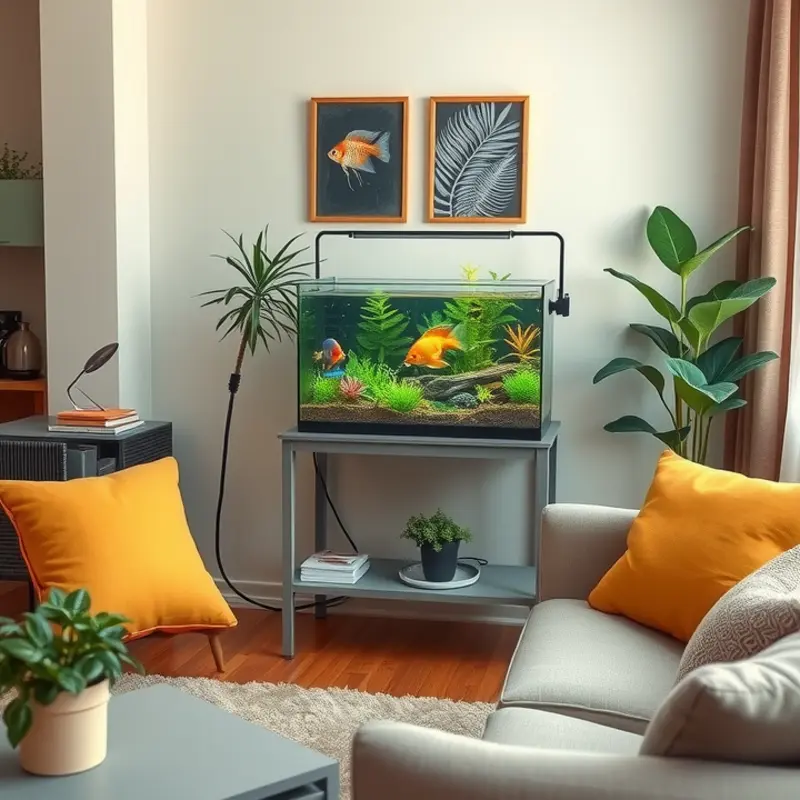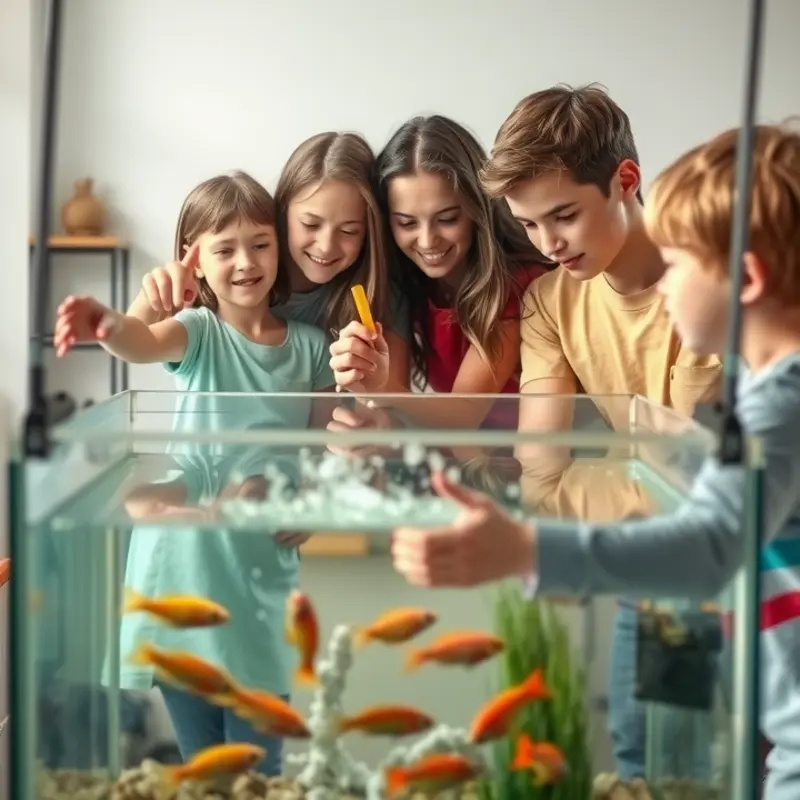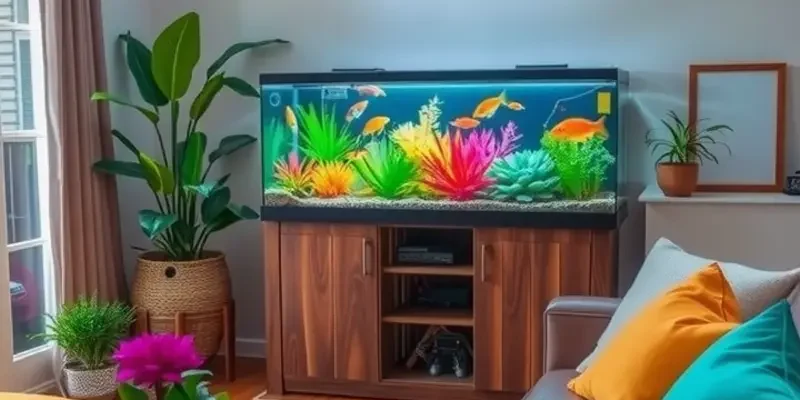Setting up a fish tank in your apartment can be a rewarding experience for families, couples, and pet owners alike. Aquariums not only add a unique touch to your living space but also provide a calming presence for children and adults. However, ensuring the tank is safe for both pets and kids is crucial, especially in rentals where space and regulations might differ. This guide will walk you through the essential steps to create a comfortable and vibrant fish tank setup that fits beautifully in your apartment. From selecting the right size aquarium to planting aquatic life and managing maintenance, our practical tips will help you create a miniature world under your roof. Let’s dive in and explore how to set up an apartment-friendly fish tank that delights the entire family and enhances your living environment!
Choosing the Right Tank for Your Space

Selecting the right fish tank for your apartment involves balancing enthusiasm with practicality. First and foremost, determine the available space in your home. Large tanks can be mesmerizing, but they demand more room and structural support. Therefore, measure the exact dimensions of the intended space, keeping in mind any furniture or other obstructions. A narrow bookshelf or a corner might accommodate a vertical tank, saving floor space while still providing a visual delight.
Consider the tank size not only in terms of its dimensions but also regarding maintenance and the type of aquatic life it will support. Smaller tanks like those that can fit on a desktop may seem easier to manage but require more frequent cleaning due to limited water volume affecting water quality rapidly. A larger tank might initially cost more, yet it provides a more stable environment with less frequent upkeep.
When considering tank size, it’s crucial to imagine the fish you wish to keep. Different species have varying space and habitat requirements. For instance, a betta fish thrives in a small tank with minimal water movement, while others like guppies prefer swimming in schools, necessitating a broader tank space. Research the adult size of your selected fish species and provide ample room for them to grow and explore.
Child safety and pet interactions are equally important factors. A sturdy stand or cabinet can prevent accidental tipping if children or pets bump into the tank. Ensure the setup is at a height where it is visible yet out of immediate reach of curious hands or paws. Anchoring furniture safely can offer additional peace of mind in homes with active children or pets.
Finally, think about the ambiance you wish to create. A tank designed for a quiet reading corner will differ significantly from one intended to be a lively centerpiece in a living room. Choose a location away from direct sunlight to prevent algae growth and temperature fluctuations. Also, ensure there’s an accessible power outlet for filters, lights, and heaters without creating tripping hazards through trailing wires.
By taking these considerations into account, your choice of tank will not only complement your living space but will also provide a healthy environment for your aquatic friends, enhancing the tranquility and beauty of your apartment.
Maintaining a Healthy and Safe Aquarium Environment

Creating and maintaining a healthy aquarium environment in your apartment requires thoughtful planning and regular attention. Implementing a consistent cleaning schedule is the first step in ensuring your aquatic pets thrive. Aim to perform partial water changes once a week to prevent the buildup of harmful substances. You can replace about 10-15% of the aquarium water each time, which helps maintain balance without drastically altering the tank’s ecosystem.
Monitoring water quality is also crucial. Invest in a reliable testing kit that allows you to check levels of ammonia, nitrites, nitrates, and pH. Keeping these parameters within their optimal ranges prevents stress on your fish, reducing the likelihood of disease. It’s also a good practice to clean the aquarium’s filter every month to ensure it operates efficiently and promotes a clean environment.
Safety measures are important both for the well-being of your fish and for the safety of your household. Place the aquarium on a sturdy, level surface to avoid any accidental tipping. Consider attaching securing straps for additional stability. Position the tank away from direct sunlight to prevent excessive algae growth and temperature fluctuations. Make sure the power cords are neatly organized and tucked away to avoid tripping hazards.
Households with young children need to child-proof the aquarium setup effectively. Ensure the tank lid is securely fastened to prevent curious hands from reaching into the water. It is also wise to position the aquarium out of reach of toddlers, ideally at a height that requires adult assistance for access. Educating children about the importance of observing without touching can also foster a sense of responsibility and appreciation for their aquatic companions.
When selecting fish, beginners may want to choose species known for their resilience and gentle nature. Consider easy-to-care-for varieties that adapt well to different conditions and are less aggressive, making them suitable for young family members to observe safely. Breeds like these can also withstand slight fluctuations in water conditions, providing a forgiving buffer as you learn the ropes of aquarium maintenance.
Lastly, establishing a system for safe water changes is essential. Use an aquarium-safe siphon to clean the substrate and remove debris. Be mindful of spills, especially when working in carpeted areas. A designated container for filling and emptying water can prevent undue mess and help maintain harmony in shared living spaces.
By incorporating these practices, you create not only a vibrant aquatic world but also a safe, engaging learning environment for your family. For further ideas on how to maintain a secure living space, consider exploring safe apartment storage practices, which can offer additional tips for organizing and protecting household items.
Final words
Setting up an aquarium in your apartment can be an enjoyable and educational experience for the whole family. By carefully selecting the right tank and maintaining a safe environment, you can create a lively and engaging space that enhances your home. Fish not only provide companionship but also foster a sense of responsibility for children as they learn to care for their aquatic friends. Remember to prioritize safety, cleanliness, and suitable fish choices to ensure your aquarium remains a joyful addition to your living space. Enjoy your aquatic adventure!









